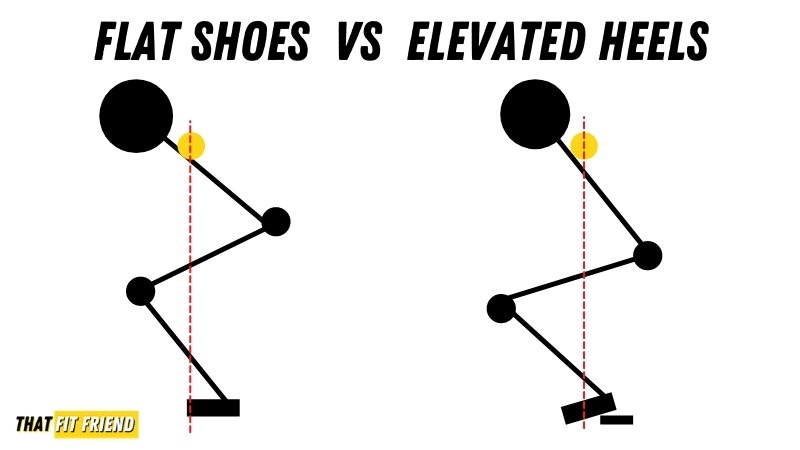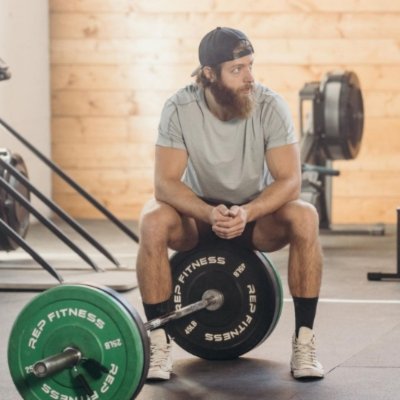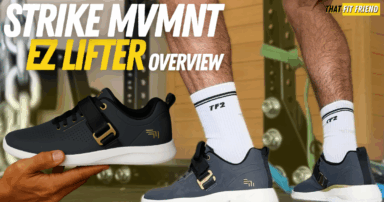Weightlifting shoes also referred to as lifting shoes and squat shoes, are supportive pieces of strength gear that athletes use to improve their lifting performance.
Weightlifting shoes come with stable outsoles and elevated heels to give an athlete a larger heel to sit into when squatting, performing lower body exercises, and Olympic lifts (clean & jerk and snatch).
One of the most frequently asked questions I receive on my YouTube channel and on training posts involving lifting shoes is, “Should beginners wear lifting shoes?”
It’s interesting when you look around the industry because there’s not a consistent answer regarding this question. Some athletes and coaches take the stance, “No, beginners don’t need weightlifting shoes and should build strong mechanics first before using them.”
I think this stance and answer is short-sighted, and it doesn’t fully contextualize the multifactorial layers of this ask. At their root, weightlifting shoes are nothing more than a heel wedge we wear on our feet.
When coaching beginners, a wedge can be a really useful tool for helping beginners truly understand and nail proper squat mechanics.
Table of Contents+
For the Record
- I’ve been coaching athletes and lifters for over a decade. As for my educational background, I have an MS in sports science and a BS in exercise science. In school, I was primarily focused on biomechanics and sports performance, and I’ve always had a deep-rooted interest in shoes and performance gear.
- Beginners can ABSOLUTELY use weightlifting shoes and the notion they can’t because, “They need to learn proper squat mechanics,” is silly. Think of weightlifting shoes as tools for improving and promoting stronger performance — just make sure you have a strategy (which is discussed in this article).
- When coaching beginners and implementing the use of weightlifting shoes, I think it’s most productive to have sessions where you’re using weightlifting shoes for certain exercises and others where you’re not. This can help beginners to acclimate to squatting in different environments. This can be useful for teaching and building a strong squat foundation.
- If you’re brand new to weightlifting shoes, ease into using them. I’d suggest using tempos that involve slower eccentrics and pauses at the bottom of the squat to help you “feel out” what it’s like to use an elevated heel for squats.
So, in this scenario, how would a weightlifting shoe be any different than a heel wedge when the goal is improving lifting mechanics? Below, I’m going to explain my rationale behind why I think beginners can benefit from wearing weightlifting shoes and why there’s no “perfect arbitrary” time to start wearing them.
Why Use Weightlifting Shoes As a Beginner?
When teaching beginners how to squat, one of the tougher areas for many to conceptualize is knee-tracking mechanics. This is when the knees track over the toes during the eccentric (lowering portion) and concentric (standing portion) of the squat. And no, the knees going over the toes in squats is not dangerous.
If a beginner is having trouble maintaining a flat foot position while promoting proper squat and knee mechanics more specifically, then a weightlifting shoe can be a really useful tool for helping them to:
- Find their balance.
- Utilize the correct muscles in their squats.
- Improve their foundational form as a whole.
Some good examples here would be the beginner who is coming up on their toes during their squat or folding over at the bottom of their squat due to sitting back too much and not allowing the knees to track properly.
As a beginner, we have an amazing opportunity to really invest our energy and time into building strong foundational lifting form.
If weightlifting shoes help us to better execute squats and really understand how to sequence the knees and hips while maintaining our balance, then why would we not utilize them to support our lifting?
Below, we’ll discuss in further detail how to start using weightlifting shoes as a beginner, what exercises they can be best utilized with, and the benefits of using them.
How to Start Using Weightlifting Shoes for Beginners
Instead of over-complicating weightlifting shoes, I’d suggest investing in a pair and experimenting with them on your lower body days.
Weightlifting shoes can, yes, be an investment up front, but they should last you multiple years if you take care of them and only use them for your lifting sessions.
Weightlifting Shoe Tip: If you want to save money, you can generally find older weightlifting shoes on Amazon and I’d also suggest checking out Nike, Reebok, and Rogue Fitness to see if they have any sales.
Once you’ve invested in a pair of weightlifting shoes, I’d suggest doing the following. If I was training you as a client, this is how I would acclimate you to your shoes.
- Start by using them on your squat day where you’ll be loading in the lighter to moderate range. The goal here is to help you feel the difference when using weightlifting shoes, so we don’t want to go too heavy, but we do want to expose you to some moderate loading to help you feel the difference.
- During this squat session, utilize a 3-4 second eccentric (lowering) tempo for all of your reps. This slower tempo will help you learn how to maintain a midfoot balance with the barbell and how to sequence your knee and hip breaking mechanics with an elevated heel.
- You can also add a 1-2 pause at the bottom of your squat to further your learning process with weightlifting shoes.
- For the next 4-6 weeks, use your weightlifting shoes during your squat sessions to acclimate to them. If you have multiple squat sessions a week, feel free to use your shoes for one session and experiment with regular training shoes for the others. This can be a useful strategy for improving your cognizance of what it’s like to squat with an elevated heel and without.
Weightlifting Shoes for Beginners Competing In Strength Sports
If you’re a beginner weightlifting, CrossFit, or powerlifting athlete, then you’ll want to use your weightlifting shoes for sessions where they’re useful for competition purposes.
For example, if you’re a weightlifter, you’re going to compete with weightlifting shoes likely, so you’ll want to wear them for your clean & jerks and snatches.
For another example, if you’re competing in CrossFit, then you’ll likely wear your weightlifting shoes for movements where you plan to wear them in competition or during training sessions where these shoes will help you maximize your performance output.
Basically, if you’re a strength athlete and you plan to compete with weightlifting shoes, treat them as part of the movement and integrate them into your regular training.
Strength sports are specific, and weightlifting shoes will help you dial in the specific mechanics needed for your sport. It wouldn’t make sense to train with cross-training shoes and then compete with weightlifting shoes.
I’m a Beginner, When Should I Wear Lifting Shoes?
As a coach, I think one of the most fun aspects of teaching lifters about weightlifting shoes is utilizing them with strategy. Far too often, I think others think weightlifting shoes are only to useful for squats and Olympic lifts. That’s not true.
In reality, weightlifting shoes can have a beneficial impact in a variety of settings even on machines like hack squats and leg presses. Let’s go through a few examples and exercises where weightlifting shoes can be useful and discuss why.
- Squats: Weightlifting shoes, when used for squats, can help you maintain the squat mechanics you’re after. For example, they can help you maintain a more upright torso when front squatting and back squatting, which will then allow you to perform more maximally and keep a midfoot barbell position.
- Clean & Jerks and Snatches: Similar to squats, weightlifting shoes used for the Olympic lifts will help you maintain a more stable base, assist your torso positioning, and increase comfort in the hole when catching weight.
- Hack Squats: We’re all built differently, and at times, certain machines may not align with our anatomy very well. Weightlifting shoes, when used for things like hack squats, can help you achieve better positioning and bias the quads by putting the ankles into an environment to feed into more knee tracking.
- Leg Press: Similar to hack squats, some leg press machines can be poorly aligned for some lifters’ anatomies. Additionally, weightlifting shoes can be a useful tool for biasing the quads when leg pressing by promoting more knee-tracking mechanics.
- Split Squats and Lunges: If you’re trying to focus on ankle mobility, knee tracking, and building the quads, then weightlifting shoes can be awesome tools for split squats and lunges. They’ll help put you into positions where you can more thoughtfully attack all of these goals.
Coaching Tip: When we talk about biasing the quads, we want to promote more knee tracking over the toes. This will help lengthen the quad and increase the stretch we place on them while mitigating load and creating an extension of the knee.
Benefits of Weightlifting Shoes for Beginners
There are multiple benefits of weightlifting shoes and I’ve discussed them in-depth in my weightlifting shoe guide, but we’ll talk about a few benefits that are super relevant for beginners specifically.
1. Great for Building Squat Mechanics
The whole “the knees shouldn’t go over the toes” sentiment is dated and needs to go away, forever. Weightlifting shoes can be fantastic tools for building squat mechanics, especially as a beginner.
They can help you conceptualize what it’s like to promote more knee tracking to utilize the quads, which are prime mover muscles in the squat. A weightlifting shoe will put your ankles into an environment where the knees can more easily track over the toes which can also be useful for those with limited ankle mobility when they first start lifting.
Note, weightlifting shoes DO NOT increase ankle mobility, they simply facilitate an easier means to squat due to them assisting with your abilities to move into ankle dorsiflexion while maintaining your balance.
Coaching Tip: Dorsiflexion is the action of flexing the ankle where the toes are pointing towards the sky.
2. Strength Sport Acclimation
If you’re a beginner who may want to dive into strength sports one day, weightlifting shoes can be useful tools for promoting training-to-sport carryover. Instead of having to adapt to weightlifting shoes later on in your lifting career, you can save yourself some time by using them early on in your training.
This will help you better understand how they can assist performance in the strength sports movements you wish to compete in them with. For example, they can help you learn to snatch more proficiently if you want to compete in weightlifting because you’ll already be acclimated to this style of strength sport-specific footwear.
3. Useful for Learning How to Bias Training Certain Muscles
As a beginner, your goal should always be to build a strong foundational form for every exercise you’re performing. Once you’ve accomplished the basics, weightlifting shoes can be a great next step for learning how to bias certain aspects of movement to target certain muscles.
Great examples would be using weightlifting shoes for split squats or leg presses to bias targeting the quads. They can promote your knee tracking abilities, which will then result in better quad usage.
Frequently Asked Questions (FAQ)
Q:Can beginners use lifting shoes?
Q:Can lifting shoes help with squats?
Takeaway Thoughts
There is no arbitrary time in which a beginner “unlocks” or earns the right to wear weightlifting shoes. They’re pieces of supportive strength gear that can be highly versatile and useful for building lifting mechanics and helping athletes acclimate to specific training settings.
The idea that a beginner can’t experiment and use weightlifting shoes is a dated logic that lacks context. If you have any further questions on this topic, drop a comment below or reach out to me personally via Instagram (@jake_boly).













Add a Comment